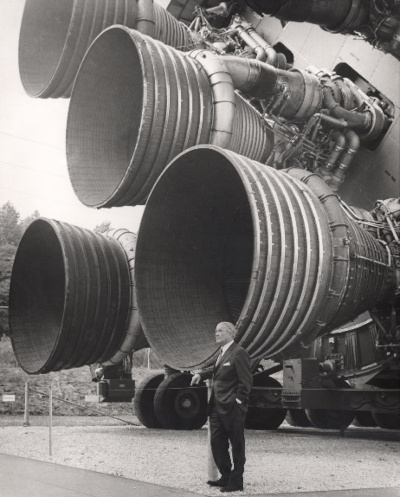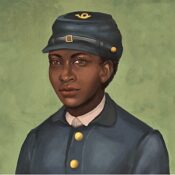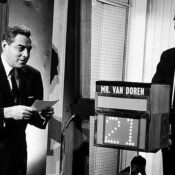This series by American studies professor Ben Railton explores the connections between America’s past and present.
On September 20, 1945, the infamous Nazi scientist Wernher von Braun arrived at Fort Strong, a U.S. military site on Long Island in Boston Harbor. In a period when many of von Braun’s Nazi colleagues were preparing to be tried in the Nuremberg war crimes trials that would commence exactly two months later, von Braun and other Nazi scientists were instead being brought to the United States to serve as prized members (and often leaders) of teams researching the space program, weapons technology, and other initiatives. Known as Operation Paperclip, this secret endeavor, led by the federal government’s newly created Joint Intelligence Objectives Agency (JIOA), would eventually bring more than 1600 German scientists — many of them former Nazis — to America between 1945 and 1959.

The Soviet Union was similarly pursuing Nazi scientists for its own weapons and space programs, and so Operation Paperclip can be framed as part of the incipient Cold War, a reflection of how quickly and thoroughly the two nations pivoted from their tenuous World War II alliance to this new, multi-decade conflict. Yet at the same time, the relationship between the U.S. government and these Nazi scientists cannot be separated from the longstanding, deeply rooted presence of Nazis and antisemitism in America. From prominent figures and voices to mass movements and rallies, the two decades leading up to World War II featured numerous connections between Americans and Nazi Germany, links that reveal that Nazism was never simply a foreign or enemy force.

One of those Americans with close ties to Nazi Germany was also one of the most successful and famous Americans of the early 20th century: Henry Ford. The automobile inventor and entrepreneur wasn’t just a strident anti-Semite—he was apparently an influence on the rise of German Nazism and even Adolf Hitler himself. Between 1920 and 1927, Ford and his aide Ernest G. Liebold published The Dearborn Independent, a newspaper that they used principally to expound anti-Semitic views and conspiracy theories; many of Ford’s writings in that paper were published in Germany as a four-volume collection entitled The International Jew, the World’s Foremost Problem (1920-1922). Heinrich Himmler wrote in 1924 that Ford was “one of our most valuable, important, and witty fighters,” and Hitler went further: in Mein Kampf (1925) he called Ford “a single great man” who “maintains full independence” from America’s Jewish “masters”; and in a 1931 Detroit News interview, Hitler called Ford an “inspiration.” In 1938, Ford received the Grand Cross of the German Eagle, one of Nazi Germany’s highest civilian honors.

After his 1927 solo flight across the Atlantic, aviation pioneer Charles Lindbergh was another of the period’s most famous Americans, and in 1938 Lindbergh likewise received a Cross of the German Eagle in 1938, this one from German air chief Hermann Goering himself. Over the next two years, Lindbergh’s public opposition to American conflict with Nazi Germany deepened, and despite subsequent attempts to recuperate that opposition as fear over Soviet Russia’s influence, Lindbergh’s views depended entirely on anti-Semitic conspiracy theories that equaled Ford’s. In a September 1939 nationwide radio address, for example, Lindbergh argued, “We must ask who owns and influences the newspaper, the news picture, and the radio station, … If our people know the truth, our country is not likely to enter the war.” Seen in this light, Lindbergh’s role as spokesman for the era’s America First Committee makes clear that that organization’s non-interventionist philosophies during World War II could not and cannot be separated from the antisemitism and Nazi sympathies of figures like Lindbergh and Ford.
American Nazism was much more than just a perspective held by elite anti-Semites — it was very much a movement. And like so many problematic social movements, it featured a demagogic voice to help spread its alternative realities — in this case, the Catholic priest turned radio host Charles Edward Coughlin. By the time World War II began, Coughlin had been publicly supporting both Nazi Germany and anti-Semitic conspiracy theories for years; his weekly magazine, Social Justice, ran for much of 1938 excerpts from the deeply anti-Semitic Protocols of the Elders of Zion, a text that contributed directly to Hitler’s views and the Holocaust. Both Social Justice and Coughlin’s radio show were hugely popular throughout the 1930s — a separate post office was constructed in his hometown of Royal Oak, Michigan just to process the roughly 80,000 letters he and show received each week—illustrating that American Nazism and anti-Semitism were widespread views in the period.

No moment reflected that American movement better than the February 20, 1939 rally that brought more than 20,000 Nazi supporters to New York’s Madison Square Garden. The rally was put on by the German American Bund, a national organization which consistently sought to wed pro-Nazi Germany sentiments to direct appeals to mythic images of American identity and patriotism. To that end, the rally was held on George Washington’s birthday, and the stage featured a portrait of Washington flanked by both American flags and Nazi flags/swastikas. After the rally opened with a performance of “The Star-Spangled Banner,” Bund secretary James Wheeler-Hill proclaimed in his introductory speech that “If George Washington were alive today, he would be friends with Adolf Hitler.” And in his closing speech, Bund leader Fritz Julius Kuhn went further, arguing that “The Bund is open to you, provided you are sincere, of good character, of white gentile stock, and an American citizen imbued with patriotic zeal.”

Yet many other Americans expressed their patriotic zeal by opposing this Nazi rally. An estimated 100,000 protesters gathered outside the Garden, dwarfing the 20,000 or so Nazi sympathizers inside. The protesters featured World War I veterans, members of the Socialist Workers Party, and countless other local and national organizations and communities. And inside the rally, one young man took such opposition a step further: Kuhn’s speech was interrupted when Isadore Greenbaum, a 26-year-old Jewish-American plumber’s assistant from Brooklyn (and future World War II naval sailor), charged the stage. Greenbaum was attacked by Bund guards, pulled away by police, and charged with disorderly conduct, for which he paid a $25 fine to avoid a 10-day jail sentence. But he was not the least bit apologetic, later stating, “Gee, what would you have done if you were in my place listening to that s.o.b. hollering against the government and publicly kissing Hitler’s behind while thousands cheered? Well, I did it.”


Greenbaum and his fellow protesters make clear that these pro-Nazi sentiments were in no way unopposed in, nor exemplary of, 1930s America. But neither can those figures mitigate the troubling realities of the rally and its reflection of widespread American support for Hitler and the Nazis, support that included some of the nation’s most famous individuals as well as tens of thousands of other Americans. In a moment when Nazi imagery and sentiments have returned to American social and political debates, we would do well to remember their deep roots in our culture.
Featured image: German American Bund parade in New York City in 1937 (Library of Congress)
Become a Saturday Evening Post member and enjoy unlimited access. Subscribe now




Comments
Absurd article equating Lindbergh’s non-interventionist activism and one speech in Des Moines – for which he was chided by America First – with an actual alliance with the Bund. He was investigated by the FBI which found no alliance. Have you, a so-called historian, ever read the FBI reports? You’re certainly no grammarian: Where did you come up with the usage “subsequent attempts to recuperate that opposition as fear over Soviet Russia’s influence” Huh? Lindbergh had long characterized Sovier Russia as an evil source. Ever read his diaries? Another absurdity of yours: “Lindbergh’s views depended entirely on anti-Semitic conspiracy theories that equaled Ford’s.” Nope, not in any way. Again, read the diary entry about his visit to Camp Dora.
Your characterization of America First as thoroughly antisemitic is also bizarre. Was Norman Thomas an antiSemite? And finally, you write that America First’s “non-interventionist philosophies during World War II could not and cannot be separated from the antisemitism and Nazi sympathies of figures like Lindbergh and Ford.” You seem unaware that the attack on Pearl Harbor and US declarations of war against the Axis powers were accompanied by the disbanding of Anerica First.
It is dangerous to perpetuate your inaccuracies through the current medium. I could not disapprove of your lax scholarship and insufficient ethics more strongly.
Great Article
The POST, along wth LIFE, were America’s most respected pictorial and news publications during the war. Yet, not one word about the war and the 75th anniversary of its end in your September issue. A major editorial failure.
Jerome M. O’Connor, author THE HIDDEN PLACES OF WORLD WAR II, published by Lyons Press.